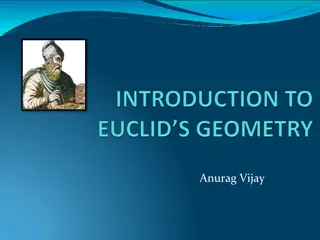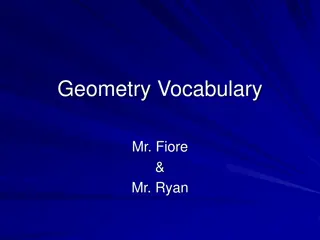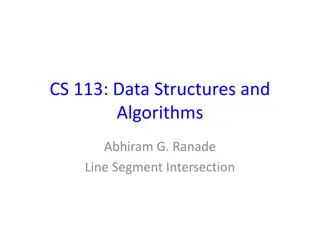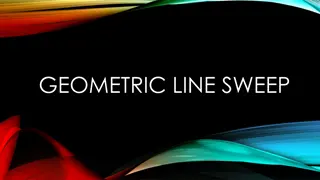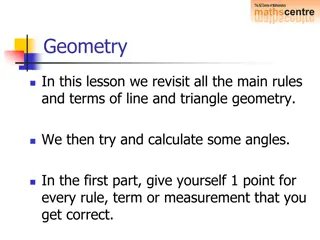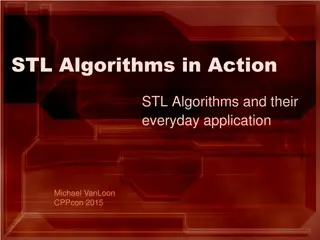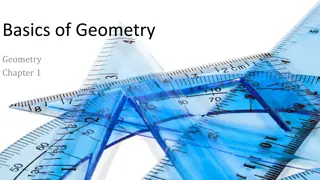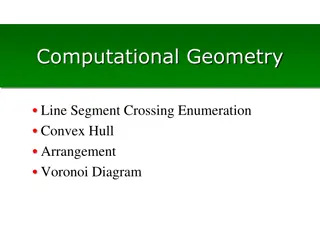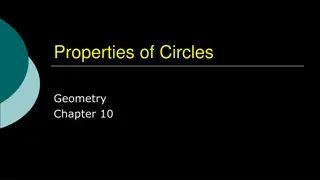Understanding Line Sweep Algorithms in Geometry
Line sweep algorithms are a powerful tool for solving geometry problems by simulating the sweeping of a vertical line across a plane. This approach allows for efficient processing of important points and addressing various geometric challenges, such as finding the closest pair of points, determining intersections of line segments, computing the total area covered by rectangles, and identifying the convex hull of points. Codeforces Problem 1028C: Rectangles serves as a practical example illustrating the application of line sweep in problem-solving.
Download Presentation

Please find below an Image/Link to download the presentation.
The content on the website is provided AS IS for your information and personal use only. It may not be sold, licensed, or shared on other websites without obtaining consent from the author. Download presentation by click this link. If you encounter any issues during the download, it is possible that the publisher has removed the file from their server.
E N D
Presentation Transcript
Line Sweep Algorithms By Adri Wessels
Basic Concept Imagine a vertical line. Imagine that line being swept across the page. Every time the line hits an important point we do something cool. At the end our problem is magically solved. Kind of like DP, but for geometry questions. Gives you a way to approach the problem.
So how does it actually work? Every point where we want to do something is added to a set or priority queue. We call these points events. The events are ordered in the order the line would hit them (usually by x coordinate). You then simply work through this priority queue or set. The hard part is figuring out what processing you need to do at each point. Because of this sorting requirement these algorithms are inherently at least O(n.log(n)).
But what problems can actually be solved by this line thingy? Find the closest pair of points. Find all intersections of line segments (complicated in general find it on Wikipedia, simple when only allowing vertical and horizontal segments) Find the total area covered by the union of N rectangles on the plane. Find the convex hull of points (very similar to Graham scan). (Thanks Robin for these examples. You con find the details on them in his presentation from 2015 on the archive.) Codeforces Problem 1028C: Rectangles.
Codeforces 1028C: Rectangles You re given the coordinates of the bottom left and upper right corners of N (1 <= N <= 132674) rectangles. Find a point that is either on or inside the boundry of (at least or exactly?) N 1 rectangles. Even though codeforces doesn t have a linesweep tag for problems, I immediately saw that this should be done via linesweep. The basic idea is to keep track of all the rectangles covered by the line. Then once at least N 1 are covered you can check to find a point that would finish the question. How to find that point though .
Codeforces 1028C: Rectangles Answer: Another line sweep! You do a vertical line sweep (so the line is horizontal) with only the rectangles currently covered by the other line. As you sweep you keep track of the number of rectangles covered. If you manage to cover N 1 rectangles with the horizontal line, then you can take the point where the two lines intersect as your answer.
Setup Code Structs: Global Variables: Input:
Real Code Based on the type of event, either add rectangle to set or remove it from the set. If the line is covering more than N 1 rectangles do the second line sweep. Notice how the second line sweep needs a set rather than a priority_queue because you need to keep the elements for possible resweeps later. Immediately print and finish if point found. Don t forget to pop the events after processing them.
Disclaimer/Indemnity Notice The code shown *mostly* works. It fails on testcase 15 on codeforces, but I haven t had time to fix it yet. The general idea is sound though. I take no responsibility for any loss of points, infinite loops, world- destroying divisions by 0 or segfaults resulting from studying and following the code too closely. This presentation was made yesterday mostly during class lol.







